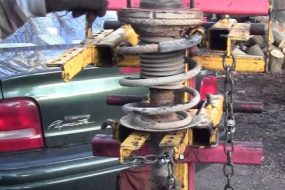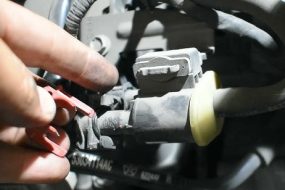Rough idling can make driving less fun and frustrating. Imagine your engine running smoothly as you navigate through the open road, but suddenly, as you come to a stop, you start feeling an unsettling shudder and hear an erratic rumble. This phenomenon is known as rough idle and usually occurs at low RPM.
Since a smooth idle is important for the overall performance and efficiency of your vehicle, the presence of rough idling should be a cause for concern. Therefore, what causes rough idle at low RPM, and how should I fix the problem?
What Causes Rough Idle at Low RPM
Here’s what causes rough idle at low RPM:
1. Faulty Spark Plugs
One of the primary culprits behind rough idle at low RPM is often faulty spark plugs. Spark plugs play important roles in igniting the air-fuel mixture in the combustion chamber.
Over time, spark plugs can wear out or become fouled, leading to inefficient combustion. When combustion is not as ideal as it should be, it can result in a rough idle.
All you have to do is to clean the fouled plug or replace the spark plugs to stop rough idle at low RPM thereby, improving smooth engine operation.
2. Dirty or Clogged Fuel Injectors
Fuel injectors are responsible for delivering a precise amount of fuel into the combustion chamber. If these injectors become clogged or dirty, the fuel spray pattern becomes uneven, affecting the combustion process.
This irregular combustion can lead to rough idle at low RPM. You can use fuel addictives such as fuel injector cleaner to clean the injectors. This should have the problems fixed.
3. Air Intake Issues
A steady flow of air is important for the combustion process. However, any disruption in the air intake system can result in rough idle.
Common problems include a dirty or clogged air filter, which restricts the airflow, or a malfunctioning mass airflow sensor (MAF).
Replacing the air filter and cleaning the MAF sensor can prevent these issues and promote smooth engine operation.
4. Vacuum Leaks
Vacuum leaks can be a silent troublemaker, causing rough idle without any noticeable symptoms. Leaks in the vacuum system, such as cracked hoses or loose connections, can lead to an imbalance in the air-fuel mixture.
Since the engine control unit (ECU) relies on a precise air-fuel ratio for smooth operation, any deviation can result in rough idle. Therefore, thoroughly inspect and repair vacuum leaks to restor and maintain a stable idle.
5. Idle Air Control Valve Malfunction
The Idle Air Control Valve regulates the amount of air entering the engine during idle conditions. If the Idle Air Control Valve becomes clogged or malfunctions, it can disrupt the airflow and cause rough idle.
You can clean or replace the Idle Air Control Valve, depending on the severity of the issue, to restore proper functionality and eliminate rough idling.
6. Throttle Body Issues
The throttle body controls the amount of air that enters the engine, and any problems with its components can result in rough idle.
Carbon deposits can accumulate on the throttle body, affecting its movement and disrupting the airflow. Therefore, regular cleaning of the throttle body can prevent these deposits and ensure smooth idle operation.
7. Engine Misfires
Engine misfires occur when there is a failure in the ignition process, leading to one or more cylinders not firing correctly. Misfires can cause a noticeable vibration and rough idle.
Common causes include issues with the ignition system, such as a malfunctioning ignition coil or a faulty ignition control module. Once you fix the root cause of engine misfires, the rough idle at low RPM will be resolved.
8. Faulty EGR Valve
The Exhaust Gas Recirculation (EGR) system is designed to reduce emissions by recirculating a portion of exhaust gases back into the combustion chamber.
If the EGR valve malfunctions or becomes clogged, it can disrupt the combustion process and lead to rough idle.
9. Fuel System Problems
Issues within the fuel system, such as a failing fuel pump or a clogged fuel filter, can result in inadequate fuel delivery to the engine. Insufficient fuel supply can lead to lean or rich air-fuel mixtures, both of which can cause rough idle.
10. Engine Sensors Malfunction
Modern vehicles rely on various sensors to monitor and adjust engine parameters for optimal performance. Malfunctioning sensors, such as the oxygen sensor or the throttle position sensor, can provide inaccurate data to the ECU, leading to rough idle.
You can use diagnostic tools to identify the sensor issue, and replace the sensor as soon as possible to restore smooth engine operation.
Solutions to Rough Idle at Low RPM
Here’s how to fix rough idle at low RPM:
- Replace Faulty Spark Plugs: Regularly inspect and replace spark plugs according to the manufacturer’s recommendations. Ensue to choose high-quality spark plugs with the correct heat range for your vehicle and consider upgrading to iridium or platinum plugs for improved durability and performance.
- Clean or Replace Clogged Fuel Injectors: Use fuel injector cleaning additives during routine maintenance and replace injectors if cleaning does not resolve the issue.
- Fix Air Intake Issues: Replace the air filter at regular intervals to ensure proper airflow. Clean the Mass Airflow Sensor (MAF) using MAF cleaner as part of routine maintenance and inspect the entire air intake system for leaks. Endevor to repair or replace damaged components.
- Fix Vacuum Leaks: Thoroughly inspect and repair vacuum leaks. A smoke test can be employed to pinpoint and address leaks more efficiently.
- Clean or Replace Idle Air Control Valve: Remove and clean the Idle Air Control Valve to eliminate deposits. If cleaning is ineffective, replace the Idle Air Control Valve.
- Throttle Body Maintenance: Develop the habit of cleaning the throttle body, ensuring the throttle plate moves freely. Throttle body cleaner and a soft brush can be used for effective cleaning.
- Address Engine Misfires: Diagnose and repair ignition system problems, including faulty ignition coils or spark plug wires. Ensure proper spark plug gap and condition.
- Clean or Replace EGR Valve: Remove and clean the EGR valve, checking for proper operation. Replace the valve if necessary.
- Maintain Your Fuel System: Replace the fuel filter at recommended intervals, check fuel pump pressure, and use fuel system cleaners to prevent carbon buildup.
- Fix Engine Sensor Issues: Use diagnostic tools to identify and replace faulty sensors. Ensure all sensors are properly connected and calibrated.
Implementing these solutions in a comprehensive manner will not only resolve rough idle issues but also contribute to the overall health and longevity of your vehicle’s engine.
Conclusion
As a driver who loved to drive and have fun while doing it, achieving a smooth and consistent idle at low RPM is important for overall performance.
Rough idle can stem from a variety of factors, ranging from ignition system malfunctions to fuel delivery issues and sensor failures.
Regular maintenance, timely inspections, and fixing issues promptly are key to preventing and resolving rough idle at low RPM.



